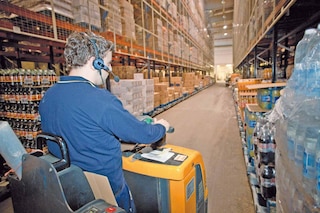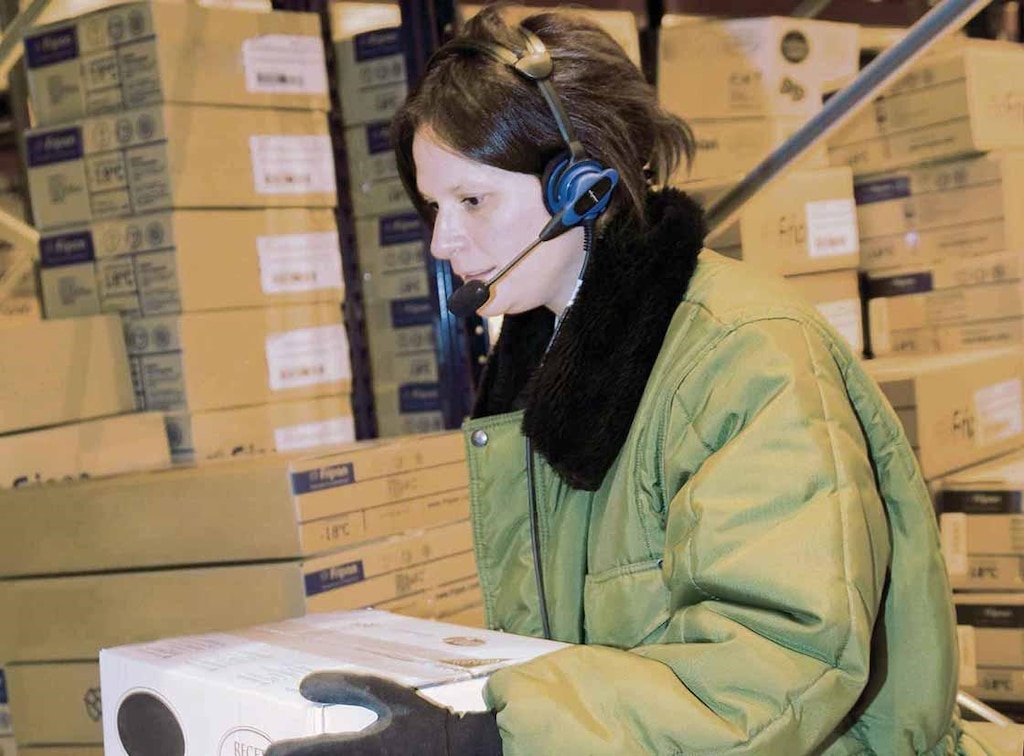
Voice picking systems: everything you need to know
Voice picking systems assist warehouse workers through verbal instructions. These voice picking devices are connected to the warehouse management system and convert the system's orders into voice commands that the operator hears on his or her headphones. Once performed, it is the operator who verbally confirms their movements. And then, that information is recorded in the system automatically.
Thanks to this system, the operator is able to move through all picking phases with speed and precision, rectifying a large part of the errors involved in order preparation.
How does voice picking work?
The warehouse operator wears a headset with a microphone, along with a control device usually fastened at the waist. The voice picking process is divided into the following stages:
- The warehouse management system relays order preparation information and the voice picking device translates it to and for the operator.
- The worker receives a message on their headset with the exact location they must go to and the SKU and quantity to collect.
- When the operator is in the right place, they say the control code into the microphone and picks the specified merchandise.
- The WMS receives the information and matches it up. It validates the remaining quantity on the shelf with the operator to check that the inventory shown by the WMS corresponds to the actual one. If successful, it records the task as completed and transmits the next picking command. If things don’t coincide, it will detect the incident and instruct the operator on the steps to follow.
- Once the entire order line has been completed, the pick-to-voice system tells the operator which printer to head to get the labels, and to finish the orders’ weighing and packing phase.
Despite what its name suggests, voice technology applications in the warehouse aren’t just limited to controlling picking and order preparation tasks. Also, it guides workers in the rest of their activities. For example, in cross-docking operations, in performing quality control, or in goods receipt tasks.
What are the advantages of using a voice picking system in a warehouse?
Voice picking systems go a step beyond traditional scanning done with radiofrequency devices. The pick-by-voice system has some very outstanding benefits in comparison:
- It increases the speed and accuracy of picking tasks
The big advantage of voice picking is that it gives workers greater freedom of movement and a wider field of vision. As a result, productivity ratios per operator increase from day one. In this respect, the Easy WMS Labor Management module is a very handy tool for analysing these data thoroughly.
The latest improvements in RF device design have transformed them into more ergonomic devices that include a ring-shaped barcode reader. However, these changes do not free the worker from looking for the location and validating the picking tasks. With voice picking, the idle time spent on these visual checks is limited.

- Voice picking systems reduce incidents
The drastic reduction in picking errors, which are now virtually non-existent, is one of the most common advantages when it comes to voice technology systems as opposed to radiofrequency devices. So, with voice picking, operators don't need to «juggle» loads with one hand and be busy holding the RF device with the other. This prevents goods from being damaged, as well as preventing occupational risks in the warehouse.
On the other hand, you avoid scan-related setbacks, such as delays caused by badly stuck or wrinkled product labels that can't be read easily. In the case of voice picking technology, just read the numbers marked on the label out loud and follow the system instructions.
- The order picking process is safer and more ergonomic
Voice picking allows operators to have both hands free to carry packages or products. If we compare it with radiofrequency picking, movements are more agile and convenient. A very clear example is tire warehouses: if picking is done manually, voice picking lets the picker hold two wheels at the same time, one on each arm, minimising the overall number of steps taken.
- Operators will find it a flexible, easy-to-learn system
Minimal training is required for the worker to start operating the voice picking system. For this reason, the system is ideal for warehouses that are experiencing major changes due to seasonality and get support from a temporary workforce depending on work peaks.
In addition, the flexibility of the system means that instructions can be broadcast in the user's preferred language regardless of pronunciation. The speech recognition system calibrates itself at the beginning of each shift to verify it is functioning properly.
- Voice picking is simple to implement and suitable for all kinds of storage conditions
Installing voice picking systems is simple and doesn't involve major changes to your warehouse infrastructure. Regarding the noise level, state-of-the-art speech recognition systems are capable of interpreting the operator's responses by separating them from background noise. In the same line, the headphones are equipped with noise cancelling systems for added comfort for the worker.
In terms of temperature, voice picking systems are well suited for working in cold stores or cold-storage installations. In fact, this type of storage installation is where voice picking has been implemented the most. For working in cold environments, operators must equip themselves with warm work clothes and PPE (Personal Protective Equipment) such as gloves that restrict touch screen interaction.
- The return on investment in voice picking is fast
Voice picking is one of the least expensive decisions to make when it comes to automation. Of course, the needed investment will vary depending on whether the warehouse is already equipped with a WMS that manages operations automatically.
Factors to consider before opting for a voice picking solution
- Voice picking is ideal for warehouses that carry an enormous variety of SKUs and run intense picking activities. Here, we would also like to highlight how convenient it is for refrigerated warehouses too.
- A WMS is a must and behind the modulated voice of this type of device is the brain of the warehouse, the management system. Without running a WMS, it is not possible to install voice picking devices and achieve this dramatic improvement in productivity.
- If you have a WMS other than Easy WMS installed in the warehouse, you should first check whether the voice picking systems can be integrated with the software. The Mecalux WMS connects to all types of picking assistive devices.
- In any case, the impact on occupational safety should be reviewed. If the warehouse operates with handling equipment such as forklift lorries, evaluate whether the employee can hear the instructions while operating the equipment. Devices with only one earpiece have been developed for this very reason.
- The warehouse must have an internet connection with a good ping speed enabled so that the information exchange can be processed quickly.
- Check whether you need to adapt some warehouse signaling. Normally, the system can be programmed to work with codes from labels already stuck on the goods. However, you may need to add codes that identify the loading and unloading docks.
Here ends our walk through the operating mode and main advantages of voice picking. However, if you are considering implementing voice picking technology in your warehouse, don’t hesitate to get in touch: we will check out your situation, design a project with a breakdown of the costs and show you the estimated ROI.
